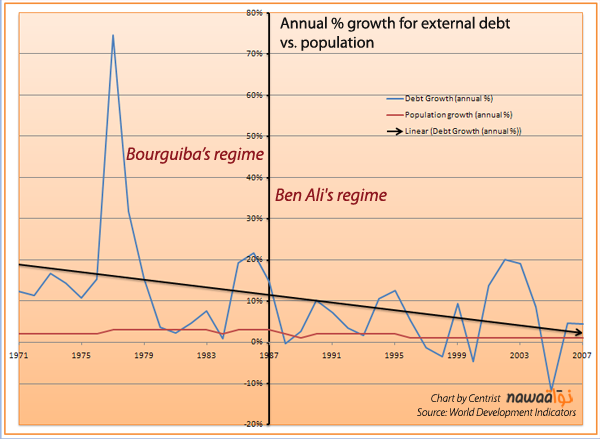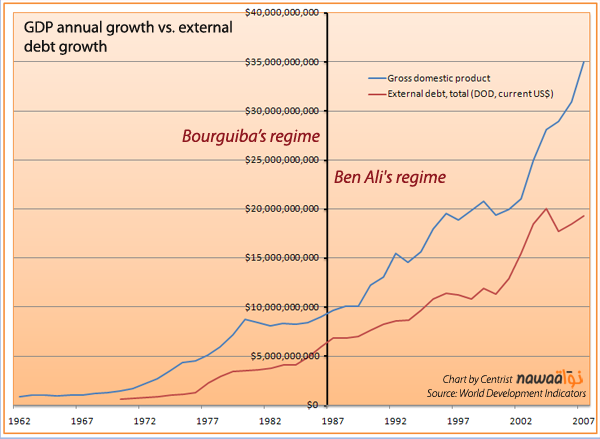Since the 60s Tunisia economic performance has been following a relatively growing trend. The strong human capital base, as well as the adaptability of the Tunisian people to transforms, and that’s due to many historical and environmental aspects, are the main factors behind the sustainable Tunisian economy.
The Government role to emphasize the economy is crucial, no question about it, although not in the case of Tunisia, where the government has always been an obstacle to a healthier economic expansion, considering all the potential that Tunisia has to pursue the path of countries like Greece, Cyprus, Malta, or south Korea. But the kleptocratic nature of the regime, as well as bureaucracy, and atrocious regulations have been drastically decelerating Tunisia’s economics prospective.
Not to mention all the efforts made by the regime’s propaganda machine to capitalize on the little progress made by the Tunisian people to draw a falsely successful picture, take the credit for it, build on it the whole strategic theme of Ben Ali’s electoral campaign, and make it the main argument for “Tunisians” to beg him and persuade him to run yet again for a fifth consecutive term!
I would further state, and according to unconfirmed sources, that Ben Ali’s personal fortune is estimated by Forbes magazine to exceed 5 Billion dollars, while the external debt per Tunisian is rising greater than ever since Ben Ali’s coup d’état, increasing from 887 USD in 1987 to nearly 2000 USD per citizen in 2008! (see External debt per Tunisian figure below)
It should be noted also, that by the end of 2005, and as stated by the Tunisian Chamber of Commerce and Industry, 194 companies had been privatized at a total value of 2.4 billion TND ($1.8 billion). In 2006 the country had seen its biggest-ever privatization operation in terms of value, when Ben Ali’s regime sold 35% of the national telecommunications company Tunisie Telecom, which represents, according to the same source, almost twice as much as all other privatizations since 1987 combined.
The figures below go over the main points of the historical growth of Tunisia’s economy, and putting in perspective Bourguiba’s to Ben Ali’s era:






2009 – Nawaat.org
Centrist




Nice post, thanks.
Can you please provide the source for Ben Ali’s fortune?. I was checking on Forbes site at but could not find him.
http://www.forbes.com/lists/2008/10/billionaires08_The-Worlds-Billionaires_Rank.html
Thanks again
Hi Samsoum,
well, I couldn’t find it neither so I updated my post to state that the source is unconfirmed.
Thanks for bringing that to my attention.
Ahla Centrist- I am by no means an Economist or claim to be an Economy guru but from the little I know, the charts you provided actually show that Tunisian Economy is in a good shape: Inflation and Dept slopes are going down, GDP is going up. The debt per person part however is a challenge all countries are facing even the US.
Ahla Bachbouch,
the purpose of the charts is in fact to show that the trend of Tunisia’s economy has always been towards net growth since the 60s, which is absolutely typical for emerging countries, and it has nothing to do Ben Ali’s policies. Now you would want to ask what would’ve been the growth rate if we had a democratic elected government that is held responsible for its acts. Well, I’m pretty sure it would’ve been pretty much different.
As for the debt, it is relatively a challenge facing all countries, but most of them are creating jobs. The US is currently facing it’s second major economic crisis ever. Over 5 million people lost their jobs; unemployment rate is at 8.5% as of March 2009.
Unemployment rate in Tunisia is hitting the 14%, and that’s according to official sources! Unofficial sources are claiming to be around 25%.
So where is the money they are borrowing if they are not creating jobs? That’s a legitimate question that has yet to be answered. And we will never get an answer for it from a regime that has amended the constitution to grant the President judicial immunity during and after his presidency!
Merci Centrist,
un tres bon article et tres bonne Conclusion/ observation (qu il n y a pas de correlation entre le changement de regime et l economie en tunisie)